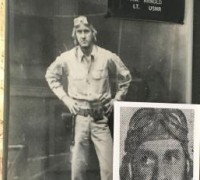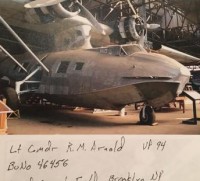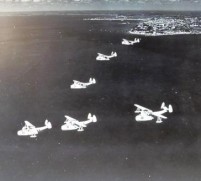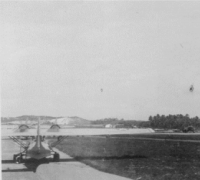U.S. NAVY VP SQUADRONS IN BRAZIL - THE TIMES OF RICHARD ARNOLD AT VP 94
2)FREEZING POINT AT GLENVIEW
Glenview was about twenty-five miles north of downtown Chicago and just a short distance from Lake Mjchigan. It was not unusual for the temperature to get down to eight below zero and there was always a strong wind coming off the lake. Every morning at about 0635, we had to muster on the flight line and stand in that cold for a half-hour or so getting our orders.
They had just added some new buildings and streets to the base so it was a pretty large. We lived in some of the new barracks that had just been built. We didn’t have rooms any more, we had double metal bunks lined up on both sides of the long open area with probably 100 cadets on each floor. So much for privacy.
When we checked in, we were given our usual physical then marched down to the supply depot to draw our flight gear. As we marched into the building, we passed stacks and stacks of large wooden boxes. Someone was foolish enough to ask what they were. The answer sobered us up when we were told they were coffins. What made it more frightening was that at that instant there was a very heavy snow storm in progress. There were six old F3F Navy fighters trying to get into Glenview right then.
We could hear them going over, pouring on the power when they missed the field, then the crash siren would sound. All six of them crashed. Fortunately, they all survived thanks to the snow banks around the field. The planes were wiped out, but the pilots weren’t seriously hurt. It did give us pause, however, and quieted down the wise guys for awhile. As in most groups like that there were some wise-guys. Our biggest gold-brick was named Bones Crampton. Somehow, he always managed to dodge work details by hiding someplace. One day he skipped out on the flight line and went back to the barracks to his bunk. The officers pulled a surprise barracks inspection that day. Bones heard them coming and went out on the fire escape and hung down along the wall where he couldn’t be seen. He got away with it as with a lot of things, but he was not a very popular guy.
The opposite of Bones was a southern boy named Louie Hatchett. Everybody liked Louie. He was a good-looking kid, played football at some southern college and gave Bones fits. Louie was another one that we later heard was lost. The flight gear that was given to us consisted of heavy fleece lined jackets, pants, and boots in addition to helmet and goggles, white scarf and face mask. They also issued us a cruise box about half the size of one of those caskets to ship our gear every place we went.
The flight gear was a God-send because we were flying open cockpit biplanes called N3Ns. When we took off with the temperature at 8 below zero, the temperature dropped 3 degrees every thousand feet we went up. So at 4000 feet, it was 20 below with your head sticking out of that cockpit. In addition to that, the airplanes had inertia starters. The cadets had to use a crank to wind up the starter. At some point when the whining sound reached a high enough pitch, you pulled on a T- handle and it is supposed to tum the prop over. As cold as the oil was in the engines, they didn’t always start the first time. On those really cold days, it was not a fun experience.
Navy primary flight training was designed to teach the students from the first day to fly an airplane the Navy way. The instructors assumed that none of us had any previous flight time. While our thirty-five hours helped us some ways, it hurt us in others. We had to unlearn what we had learned. We were taught to bring an airplane in for a landing in a nose high, tail low attitude and to land in the very first part of the runway. That was with the tail hook in mind. The training was set up in stages. The first stage, A, was indoctrination. There were take-offs and landings, stalls and spins and other simple maneuvers just to teach us the basics of getting an airplane up and down safely.
We did them with an instructor and then solo. My instructor was Ensign Clipson, another easy going, nice guy. At the end of each stage, we were given a flight check by a different instructor to make sure nobody was playing favorites with their students. We all knew who the Santa Clauses were and who the automatic down checks were. If you got a down, you had two more check flights, each with different instructors. If either of them gave you another down, you were automatically a Seaman 2nd Class, washed out. So flight checks were a lot of pressure.
Each stage included new things plus refining the old ones. The next stage got us into acrobatics. We learned how to do snap rolls, split Ss, loops, slow rolls, and other designed to get us to feel as one with the airplane. The good acrobatic pilots felt like they just strapped on the airplane and it was part of them. I wasn’t one of those. It was in this stage that we lost our first fellow cadet. We were lectured over and over about showing off or being hot rocks;. Apparently some of the people giving the lectures didn’t think it applied to them. Joe Clark’s instructor decided to show Joe how to make a run on a gun emplacement at Great Lakes Naval Station. (He probably had never made a real one.) He misjudged and hit the anti-aircraft gun. Joe’s seat was ripped from the plane and he was killed - the instructor survived.
Bruce Weart and I were elected to take the body home for the funeral. Of course Joe was a very popular young man in Henin, Illinois, and there were three different ceremonies. At the grave site, we folded the flag and presented it to Joe’s parents. Taps was played and it finally ended. We got on the train and went back to Glenview, sadder and wiser. I met my hot rock instructor in a later phase of flight training. I made it through acrobatics without any downs, but I’m sure the Navy knew how good I was at it. My instructor may have told them about my snap roll in which I snapped the stick back and to the left, then kicked right rudder instead of left.
The airplane sort of stopped in mid-air then went into a spin. After he pulled us out he just laughed and asked if I was trying to “sprain” the airplane. Luckily he had a sense of humor. The next stage was night flying. Fortunately, we only had a few hours of it because the weather had been bad so long we had to fly all night a few nights to get it in. We would fly an hour and a half, sit on the ground the same length of time, then fly again, sit again, and fly again. There ,were always fifteen or so airplanes in the air at one time. There was a high circuit just circling, while the lower group shot landings. New pilots who were unfamiliar with night flying dodged every light they saw so it was, wild. The instructor would go around once or twice, say you were safe for solo, taxi in and get out. It took a lot of nerve to go because he had done all the flying.
You wonder how he knew you were safe. We had no radios and did everything by red and green flares fired from the ground. Green meant we were cleared to land, red meant to go around. The landing area was a short runway outlined by four flare pots in a row designating each side of the runway. It was pitch black and we had no landing lights. With all the planes vying for that small area, it was an invitation to disaster. That was when we lost our second cadet. It happened late one night that I wasn’t flying. I was awakened by the duty officer and told to go to sick-bay because I had the same type of blood as the cadet who had been landed on. I didn’t know him but everybody knew the other pilot. His name was Campbell Kane and he had been an Olympic runner.
He wasn’t hurt. I gave a blood transfusion but it was hopeless because he had been virtually cut in half by the prop. He did live for a number of months but eventually died. It was amazing that we didn’t have more of it. The training command was trying to set records for number of training hours flown in a month. The same thing happened later in my Navy career and cost the lives of thirteen people, two of them my newly assigned co-pilots. The last stage of our primary flight training was formation flying. We had to learn to fly two or three airplanes in close proximity to each other. We had to learn to keep the wings parallel to the lead plane and skid the airplane around with rudder only to hold our position.
We learned to cross over or under depending on whether we were stepped up or down. We had to fly in a V formation or an echelon (in a line staggered back like geese) and change from one to another. We would change lead by tapping our head and pointing to the other plane. We still had no radios. All of these things were demonstrated by instructors, then practiced by student’s solo. Upon completion of this stage, we were ordered to Pensacola or to Corpus Christi, Texas, for the balance of our training.
Dave Biggs, Bruce Weart, and I were ordered to proceed to Corpus Christi Naval Air Station for advanced training. Dave was another cadet who had been in Iowa City with us and had become a good friend of mine. He was the son of an executive of one of the large St. Louis banks and was very wealthy. Both of Dave’s parents had died and Dave had a guardian, a lawyer named Harry Crane. When Dave reached the age of twenty-four, he came into his inheritance which was about four million dollars, a lot of money in the 40’s. That happened while we were at Glenview and we were unaware of it for a long time. We did notice that money didn’t seem to be a problem for Dave.
Cont.



